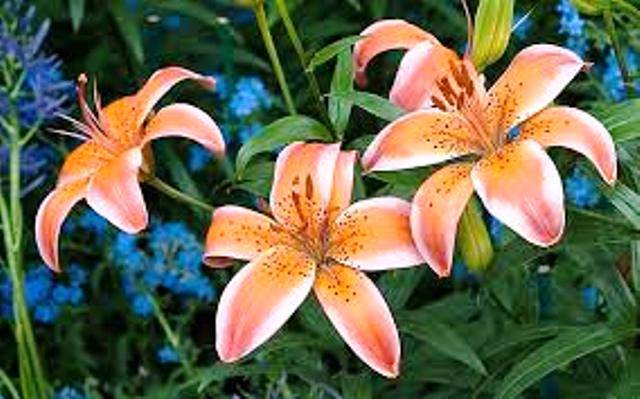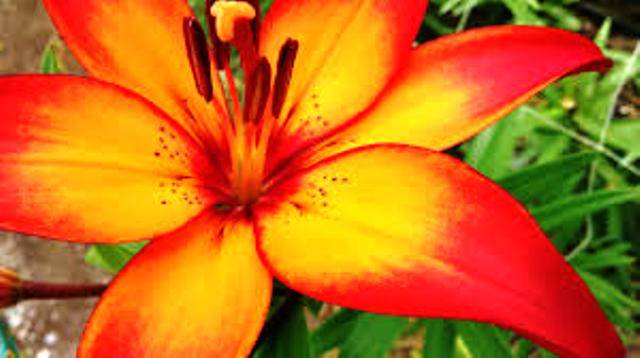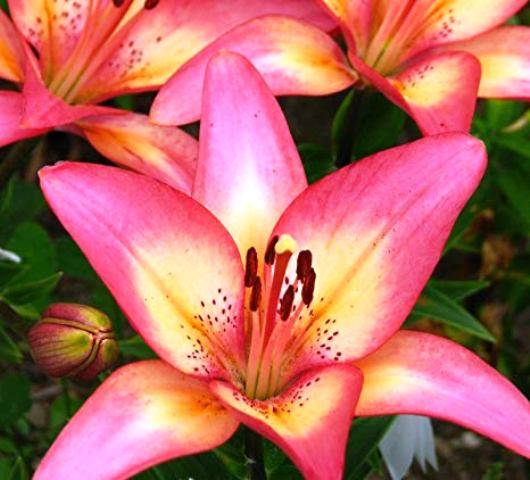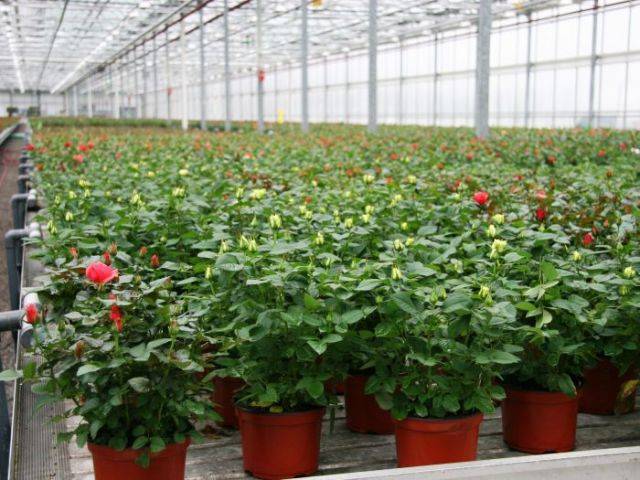
Lilium is the genus of herbaceous flowering plants growing from bulbs, all with large prominent flowers. Most species are native to the temperate northern hemisphere, though their range extends to the northern subtropics. Many of the plants have Lillie in their common name but are not related to true lilies.
The flowers are large often fragrant and come in a range of colors including whites, yellows, oranges, pinks, reds, and purples. Markings include spots and brush strokes. The plant's flower in late spring and summer. Flowers are born in racemes and umbels at the tip of the stem, with six tepals spreading or reflexed.
Seeds ripen in late summer. They explicit varying and sometimes complex germination patterns, many adapted to cool temperate climate.

Varieties
Asiatic hybrids: Dreamland (yellow), Brunello (orange), Novona (white), Pollyanna (yellow), Yellow Giant (yellow), Vivaldi (pink), Black Out (Deep red)
Oriental hybrids: Star Gazer (Pink & white), Nerostar, Siberia, Acapulco (cyclamen pink) and Casablanca Eastern lily (L.longiglorum): Elegant Lady, Ace Snow Queen, White, American, Croft and Harbo
Climate: Liliums are the best grown in green houses, day temperature of 18-22C and night temperature of 10-15C are ideal.
Soil: Well-drained sterile medium (preferably leaf mould cocopeat and FYM in equal parts) with Ph 5.5 to 6.5 is ideal. Fumigate the beds with Dazomet @30g/m2
Propagation: Liliums are commercially propagated through bulbs. A six-week cold storage period at 2C to 5C is needed to break dormancy. Bulbs can be stored at -2C upto one year.
Spacing: 20x15 cm, 15x15cm or 15x10 cm (plant density varies between 30 and 60/m2 depending on cultivar and bulb size)

Irrigation: 6-8 liters/m2/day during summer and 5-6 liters/m2/day during winter
Crop support: Supporting plants with nylon mesh is advisable.
Plant Protection
Pests Aphids: Apply Imidacloprid 17.8% SL@1ml/l or Dimethoate 30 EC @ 2 ml/l
Mites: Spray Wettable Sulphur@ 1.5g/l or [email protected] ml/l or Propargite@2ml/l
Thrips: Spray Methyl demeton 25SEC@2ML/OR Dimethoate 30EC @ 2ml/l
Diseases:
Grey mould: Spray Zineb@ 2g/l
Bulb and Scale Rot: Soil drenching with Carbendazim @ 1g/l or Difenoconazole @ 0.5ml/l
Foot rot & Root rot Soil drenching with Metalaxyl @ 0.1%
Botrytis Blight: Dark brown spots on leaves, spraying of carbendazim @ 2g/lit of water effectively control the disease.
Harvest: Harvesting is done when lower most bud shows color) color breaking stage) but is not open.

Crop duration
Asiatic hybrids: 8-10 weeks
Oriental hybrids: 14-16 weeks
Yield: The average yield is 30-40 flower stems/m2
How to grow Lilium in greenhouse
The standard type of greenhouse is required for the growth of Lilium which needs conditions like temperature, air circulation, ventilation and light. These factors have to be controlled accurately. A standard height of 4 to 4.5 metre is customary this will provide sufficient room for installing the irrigation and lighting system. Plenty of light is required for the proper cultivation.
Heating system
In many regions, the greenhouse needs to be equipped with a heating system. Asiaticand LA hybrids require minimum greenhouse temperature of 8-14 degree Celsius to other groups require 15-16 degree celcius to achieve these temperature a norm of the heating system is approximately 220 Watt/metre square of greenhouse volume/hr to provide better heat distribution and climate control ‘HEATING SYSTEM’
CO2 SYSTEM
CO2 injection benefits the growth and flowering of longiflorum hybrids and is thus recommended since it produces a sturdier and a greener crop. With the help of hanging burners the gas is supplied from the central boiler or pure CO2 injection is started upon sunrise and can be continued for a few hours to throughout the day on condition that the greenhouse is closed or little ventilation is carried out and there are sufficient light for photosynthesis.When using assimilation lighting, CO2 injection can be carried 24 hours a day. Keeping track of CO2 require monitoring using a simple monitoring device.

Light equipment The location of the meter is important for the growth of plants with respect to lighting.
Humidity The optimum humidity inside the green house should be 80 to 85 %.
Forcing The bulbs require cold treatment from 2-40° C for 6 weeks in case of Asiatic hybrids and 8 weeks for the oriental ones
Bedding media It is advisable to maintain the Ph of 6-7 for Asiatic and longiflorum hybrid groups and a Ph of 5.5 to 6.5 for oriental hybrids. The chlorine in the soil should not exceed 1.5 mmol/lit.
Coco peat Cocopeat requirement is 19 kg/m.
Planting depth Lilium bulb should initially be planted at the planting depth of 6 inches. Planting depth varies according to the size of bulb.
Irrigation The amount of water depends on the type of soil, moisture content and variety. Water requirement in summer 6-8 lit/m2 per day.
Fertigation It is advisable to apply 12:61:00 @ 2kg/100m2 atleast one week before plantation. Three weeks after plantation Calcium Nitrate @ 1kg/100m2. Six week after plantation Potassium Nitrate @ 1kg/100m2. If plants are not strong enough during growing period due to nitrogen deficiency then a top dressing of Ammonium Nitrate @ 1 kg/ 100 m2 can be applied upto three weeks before harvesting.
















